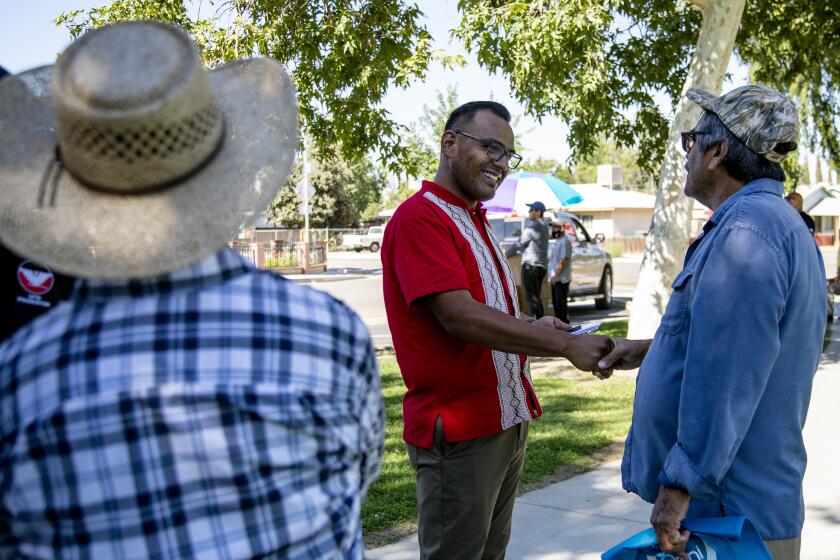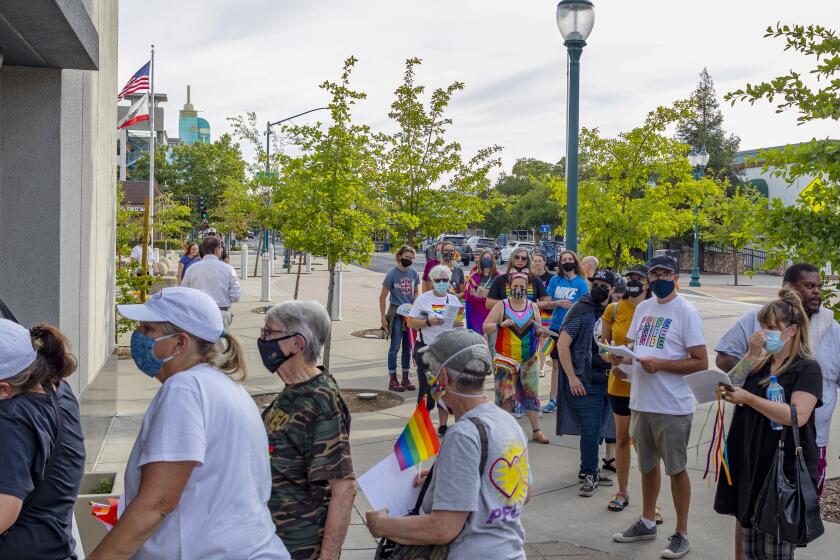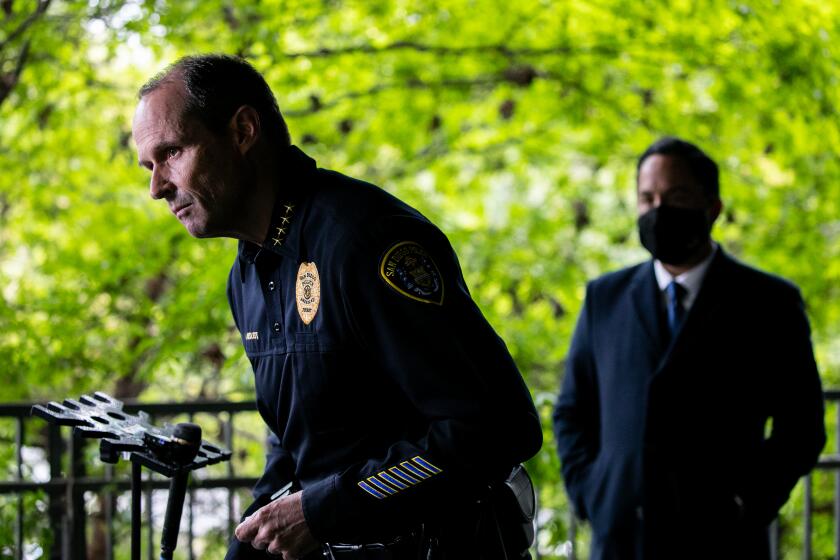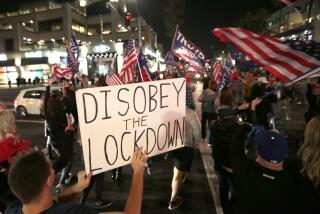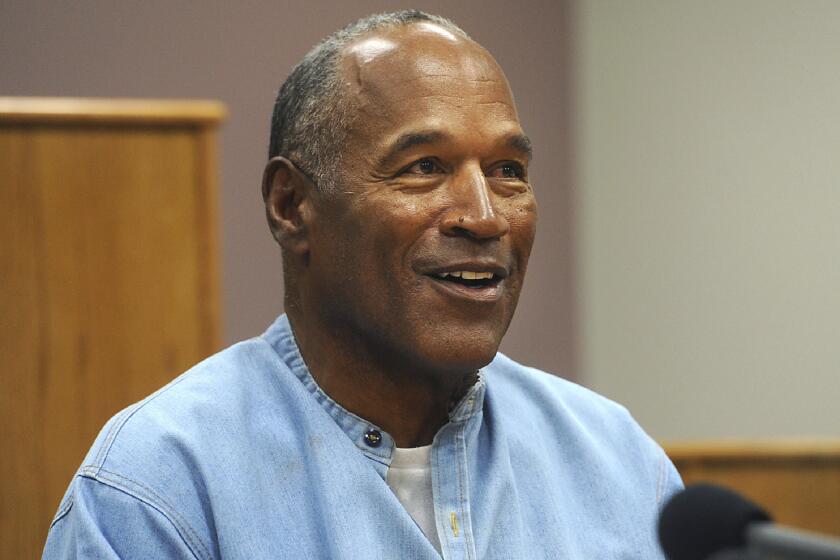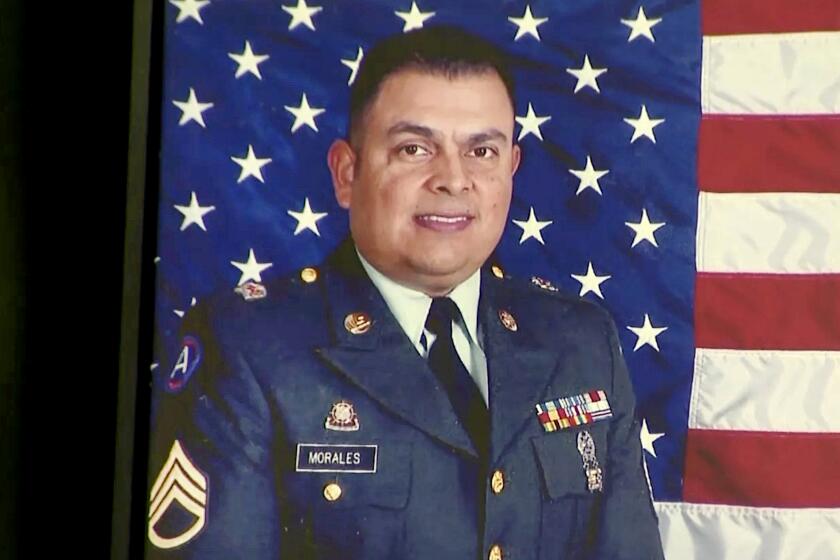Pride patches on O.C. police uniforms: Progress or performative activism?
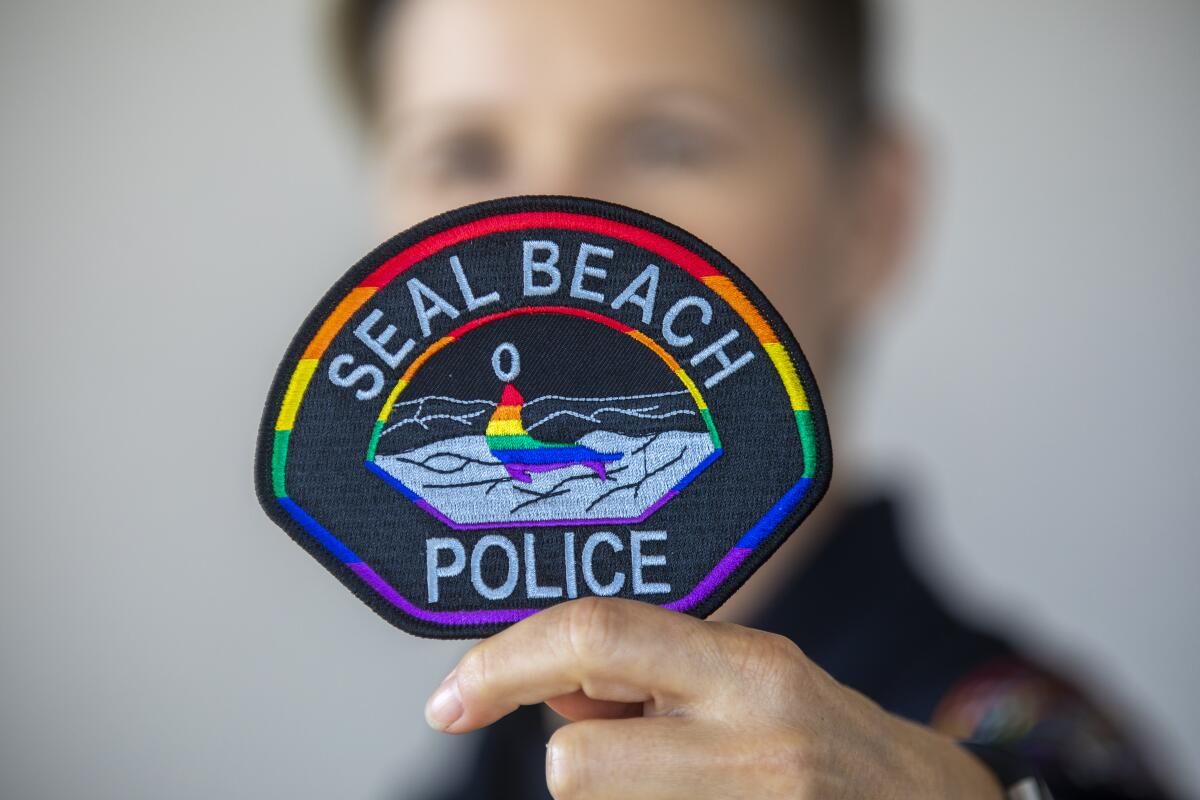
For decades, law enforcement has neither accepted nor embraced the LGBTQ community — especially not in traditionally conservative regions.
Maybe that’s why Officer Erin Enos was shocked when the Seal Beach Police Department granted her request to create a rainbow-themed patch to be worn on police uniforms during LGBTQ Pride Month.
Enos, a lesbian, knows the rejection and judgment that comes with being in the marginalized LGBTQ community. She grew up in rural California when coming out was not only unacceptable but dangerous.
She hesitated when a colleague suggested she pitch her idea for a police pride patch, one that would join a collection of special law enforcement insignia honoring other causes, such as awareness for breast cancer or autism.
“I’m not naive to the fact that there might be some people that didn’t appreciate it in Orange County, our city or in nearby cities,” Enos said. “I’m not blind to that, so that made me a little nervous.”
The rainbow-wrapped pride patch — the first of its kind for a police department in Orange County — was a bold step in what was long a famously red county.
A wave of LGBTQ activism splashed over the Central Valley, with Fresno, Delano, Selma and Tehachapi honoring Pride month. But one mayor hit a roadblock.
In Orange County — where former President Reagan said good Republicans go to die and where John Wayne crudely alluded to gay people as “perverted” — homophobia has long been on display.
Disneyland prohibited same-sex dancing until 1985. The city of Costa Mesa decades ago denied a “gay church” permit to John Rule, who helped start the LGBTQ Center OC, now in its 50th year. Bumper stickers with violent, homophobic language were sold in Huntington Beach surf shops until the late 1980s. And in 2008, Orange County voted 57.5% in favor of Proposition 8, a ballot measure that sought to ban same-sex marriage. More than half the state approved the measure, which was later overturned in court.
“Back in the early ’80s, it was not an easy place to be an openly gay person,” said Michael Losquadro, a gay man who serves as a reserve lieutenant in the Orange County Sheriff’s Department. “But the demographics are changing. Attitudes are changing.”
Indeed they are. The Seal Beach Police Department’s pride patch debuted days before Irvine police finalized their own insignia, which officers wore throughout June. And inspired by its neighboring agencies, the Laguna Beach Police Department is looking to develop its own rainbow patch, Sgt. Jim Cota said.
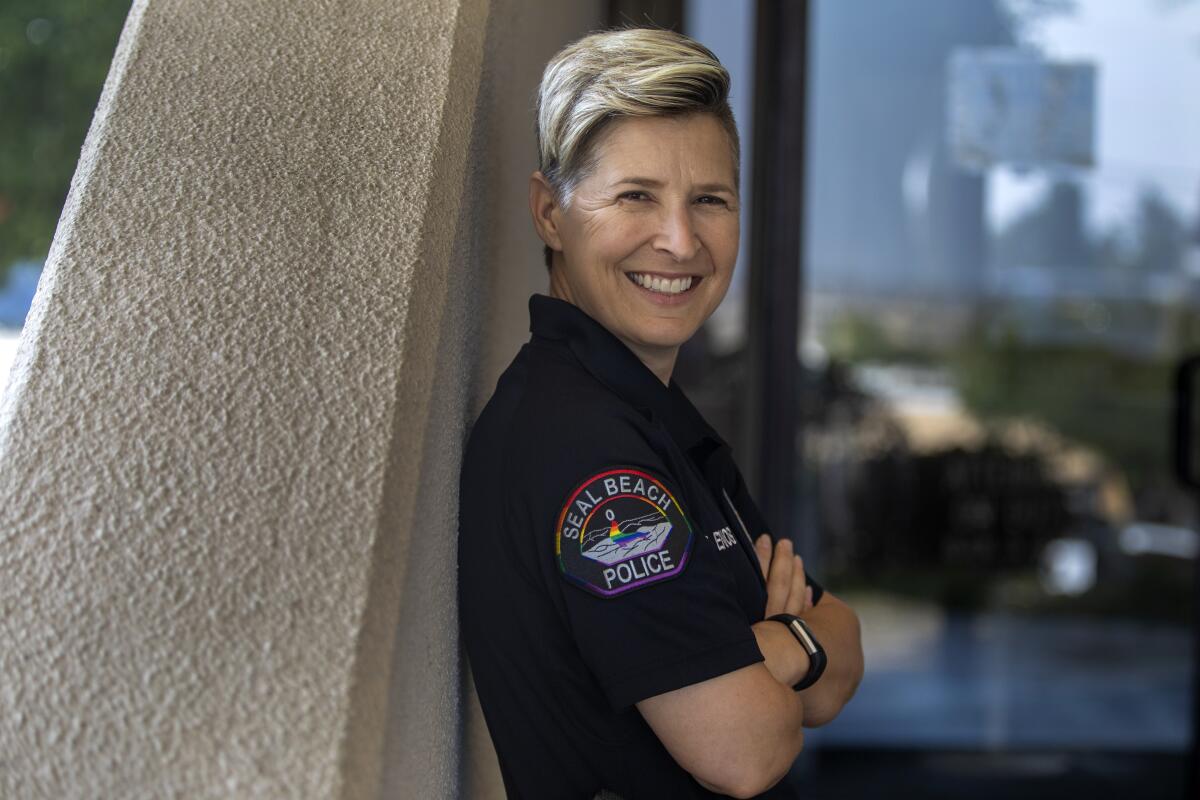
In addition, a growing number of Orange County cities have raised rainbow flags at City Hall. Some areas, including Seal Beach and Ladera Ranch, held inaugural pride festivities this year.
And cultural diversity trainings that include information on LGBTQ issues and the nuances of gender and sexual identity are becoming common in police departments.
But some question whether the pride patches symbolize Orange County’s shift toward a more inclusive and progressive era or are performative activism.
Siobhan Brooks, an associate professor of African American studies at Cal State Fullerton who wrote the book “Everyday Violence against Black and Latinx LGBT Communities,” said the rainbow revolution is just another example of how social movements have become commodified.
“Maybe there can be some good things out of it, but I think ultimately the most vulnerable people in these communities — like queer people of color, and LGBT communities — are the ones that don’t necessarily benefit from institutions like policing,” Brooks said.
For centuries, laws and police agencies have oppressed the gay community, raiding gay bars and prohibiting cross-dressing. In 1969, thousands marched against such discrimination and the police brutality that accompanied it in New York in the Stonewall uprising, which marked the beginning of the modern LGBTQ rights movement.
Today, lesbian, gay, bisexual and queer youth and adults are six times more likely than the general population to be stopped by the police, according to data published in May by the UCLA Williams Institute. And survey results indicate that nearly 1 in 4 LGBQ people say they are unlikely to call the police. The study did not include transgender people.
That ingrained historical distrust between the police and members of the LGBTQ community muddies the meaning of the pride patch for some.
“It’s a great idea, and I’m not saying wearing patches is bad. But me, as a transgender woman, seeing someone wearing an LGBTQ patch as a police officer will not make me feel safe,” said Khloe Rios-Wyatt, president and chief executive of Alianza Translatinx, a Santa Ana-based organization led by transgender people. “It’s your action. It’s what you do to help people, and we’re not getting that from police officers.”
Law enforcement agencies should hire more LGBTQ officers, Rios-Wyatt said. Only then will departments understand what it’s like to live in Orange County as a member of the LGBTQ community, she said.
Several residents asked the Roseville City Council to consider a motion that would allow them to fly the flag in recognition of the LGBTQ community. The council voted against it.
But even gay police officers aren’t always welcome among the broader LGBTQ community.
Pride organizers and LGBTQ activists across the country have grappled for years with whether to allow police, either in or out of uniform, to participate in marches. Some argue their presence defeats the original intent of the march and is offensive to LGBTQ people of color, who face ongoing harassment and discrimination. But others argue that including officers helps foster a solidarity and alliance among the broader LGBTQ community.
In 2019, the LGBTQ Center OC came under fire because Losquadro and colleagues from the Sheriff’s Department marched in uniform alongside the organization in the county’s pride parade. It wasn’t the first time uniformed police marched with the group, but its undertones struck a different tone on the 50th anniversary of the Stonewall riots.
The center, the longest-serving LGBTQ institution in Orange County, promised a series of roundtable discussions.
“Our decision to allow uniformed police officers to march with us may not have served our entire community,” the group said in a statement at the time. “For those who felt further marginalized by our decision, we sincerely apologize.”
Pride celebrations went virtual last year during the COVID-19 pandemic, and OC Pride organizers held a farmers market this year in lieu of a march.
Losquadro, who once looked up the word “gay” in a phone book and found the hotline for the Gay and Lesbian Community Services Center of Orange County — the forerunner to the LGBTQ Center — felt especially shunned during the 2019 event.
“That was a very difficult time for me, trying to listen to those who were opposed to us being in the parade but at the same time trying to inform, educate,” he said. “I was portrayed as being this rigid, you know, right-wing, law enforcement, white-privilege guy when I’ve lived for 37 years serving the LGBT community and helping to secure equality and acceptance for our community. It was like they didn’t know that or didn’t care to hear any of that.
“They just wanted me out because I was a guy in a uniform with a gun,” Losquadro said.
Rules say police will refer to people by their pronouns, book transgender and nonbinary individuals into jail facility that aligns with identity
As more communities push to champion diversity and inclusivity, Irvine Police Sgt. Karie Davies said it makes sense to have that kind of outreach start with law enforcement agencies.
Sheriff’s Department spokeswoman Carrie Braun said the agency partners with multiple organizations, including the LGBTQ Center. Sheriff’s officials regularly meet with LGBTQ community members about how to improve interactions.
In Irvine, the Police Department realized it should make its own pride patch after changing its profile picture on social media into a rainbow flag in June, Davies said. After a few mock-ups and approval by two LGBTQ officers and Chief Mike Hamel, the patch went into production.
“Traditionally, it’s a little more conservative down here, but it was time,” Davies said. “We should’ve had these five to 10 years ago.”
The Irvine Police Department ordered 300 patches, and Seal Beach police got 200. In Irvine, 55 of the emblems were given to personnel, and the rest were sold to the public. Seal Beach police didn’t say how many patches went to employees, but Enos said many officers returned their patches so they could be sold to the public afterward. Money raised from Seal Beach’s sale was being donated to the Trevor Project, a nonprofit focused on suicide prevention in the LGBTQ community.
For Enos, the pride patches are a step in the right direction. Law enforcement has made a “huge shift” since the Stonewall riots, she said.
Last month, she joined Seal Beach’s inaugural pride parade in uniform with her wife. She led the parade in a police car decorated with a rainbow flag draped along the rear window. In another shift, Enos and her wife were joined by other officers as well as Seal Beach community members.
“It’s kind of surreal,” she said. “I’m working in a culture that is so accepting that they’ll slap it on their shoulders and wear them with pride, even if they’re not in the LGBTQ community. They’re an ally to us.”
She hopes others will see that progress too.
More to Read
Start your day right
Sign up for Essential California for news, features and recommendations from the L.A. Times and beyond in your inbox six days a week.
You may occasionally receive promotional content from the Los Angeles Times.

